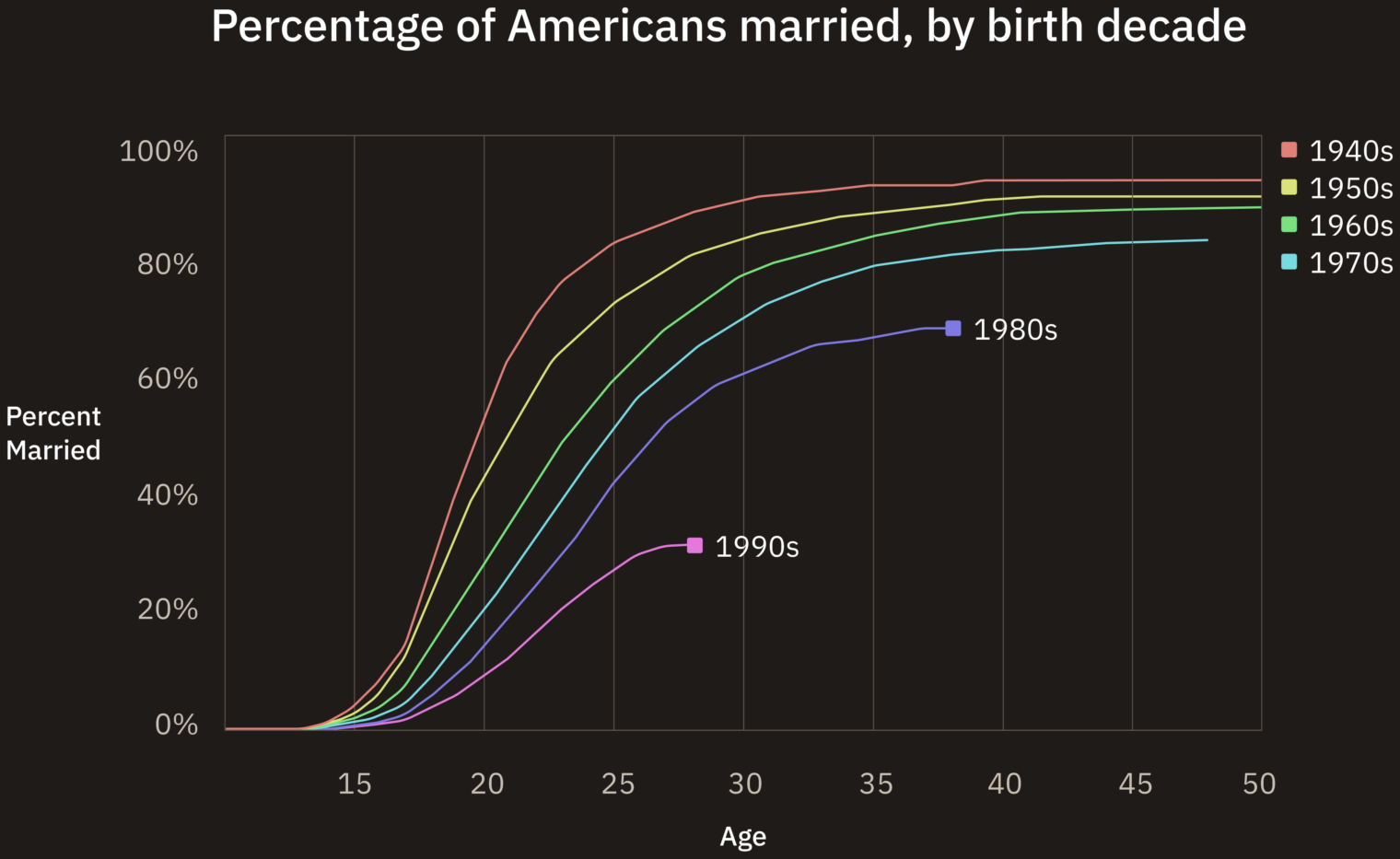A hedge fund manager pointed out “Human Reproduction as Prisoner’s Dilemma; The decline of marriage in the West.” (Aporia, January 21, 2025):
[the effort required to raise a child to adulthood] makes human reproduction analogous to a prisoner’s dilemma. Both father and mother can choose to fully commit or pursue other options [“cooperate” or “defect”]. In this context, marriage provides a framework for encouraging, legitimizing, and stabilizing commitment. … A [men defect/women defect] society looks like the most primitive parts of sub-Saharan Africa or the Amazon rainforest. Women sleep around, while adult men prey on women and children and regularly kill each other for access to women. As men can have multiple wives and wives are not loyal, there is no respite from intrasexual competition; you can always be replaced. Without paternal certainty, men have no investment in the future and spend their time fighting, dancing or resting rather than working. Economically, these societies are desperately poor and largely incapable of collective action. In war, they shatter like glass when faced with an enemy that expect chastity and fidelity from women.
What was the U.S. for its first 200 years? A “men cooperate/women cooperate” society in which there was monogamy and “Divorce is difficult: the marriage contract can be created by mutual consent, but cannot be unilaterally dissolved.”
What has the U.S. been since no-fault (“unilateral”) divorce become available circa 1970?
The shift from a cooperate/cooperate marriage system, where both men and women made sacrifices to gain the security required for childbearing, to a cooperate/defect one, where men are expected to uphold their end of the bargain in exchange for nothing, has failed. This is the legacy of second wave feminism. Men are dropping out of work or burning things down, and both marriage and children are increasingly relics of the past. We are thereby moving towards a defect/defect system of the kind I described at the start.
Why are there so many females trying to have babies with rich guys?
Polygamy is a natural attractor state for humans, since it satisfies the desires of powerful men to have multiple wives and the desires of women to have elite husbands. Monogamy requires both elite men and many women to sacrifice their desires. … Rather than invest in additional wives, men in monogamous societies invest in their original wife and children, with the result that almost everyone is better off.
Where’s the game theory promised by the article title?
But unilateral divorce doesn’t just destabilize marriage. It also changes the power dynamics within marriage from favoring the more committed partner to favouring the less committed partner. Hence, “under unilateral divorce, the distribution of resources within marriage favors the spouse who wished to divorce” (Reynoso 2024). In addition to destabilizing marriage, unilateral divorce incentivizes poor behavior within it, since the threat of ending the marriage on unfavorable terms for the undutiful partner no longer exists. This “weakens the bargaining power of dutiful partners who wish their marriage to continue or who wish to end their marriage because of serious mistreatment by the other partner” (Rowthorn 1999).
Unilateral divorce is sometimes portrayed as an advance in human freedom, but this is a mistake. By removing the ability to credibly commit to a long-term relationship, unilateral divorce prevents couples from reaching a mutually-beneficial bargain that greatly assists in the raising of children. Without forced marriage, which has never been part of the Western tradition, unilateral divorce actually removes an important choice.
The fact that individuals can now exit easily, and unilaterally, from a relationship makes it difficult for couples to make credible commitments to each other. They can promise anything they want, but most of these promises are no longer legally enforceable, and many are undermined by social policies which reward those who break their promises.
Because it no longer guarantees security (or anything else), marriage is much less useful and therefore less appealing.
What about marrying the government?
Rather than merely supporting their own wife and children, men are expected to support women to whom they have no relation, and from whom they can claim nothing in return. Not only is this much less motivating, but it also removes a major incentive for women to marry in the first place. The state can simply extract a potential husband’s wealth and transfer it to her, no marriage required.
How long will it take for family law to turn the U.S. into a richer version of the poorest African countries?
It takes generations to see these effects in full. Not only are we the product of millennia of selection for marriageability; social norms are sticky. At first, men see that their fathers worked hard to get married and that their older acquaintances are doing the same, and imitate them. Women aspire to marry as their mothers did. Even when the law has changed, the norms do not immediately disappear. But they get weaker every generation. People see that marriage no longer offers stability. They see their peers and parents ruined by divorce. They see that they can get the economic and sexual benefits of marriage without giving up options. And the old norms erode.
Why are prime-age men disappearing from the labor force (Obama White House)?
The post-60s settlement attempts to force men to transfer resources to women via the welfare state and child support. But as the Soviets discovered, it’s very difficult to get men to work to the best of their abilities through coercion alone. Without marriage, the state loses its taxpayers and society loses the men who make it work.
What about the baby bust that Elon Musk, whose first wife and mother of his children suggested divorce, decries?
By providing a solution to the prisoner’s dilemma of human reproduction, marriage greatly boosts fertility, even today. It’s not surprising that the shift from a cooperate/cooperate marriage system to a cooperate/defect one, and the attendant devastation of the institution itself, corresponds precisely to the end of the Baby Boom.
Happy Valentine’s Day, therefore, to those who celebrate, those who are married, and those who are married to the government!
(Bad news for those who are married: The article notes that, despite the ease of exiting unhappy marriages provided by no-fault divorce, marriages today are less happy than in the (good/bad) old days.)
Male readers: What percentage of your time is spent doing tasks that you wouldn’t have to do but for the fact that you’re part of a family with children? My personal number is about 80 percent. This includes house-related tasks (if it were just me and Mindy the Crippler I could live comfortably in an apartment or condo). It includes all work for wages (I have enough money from previous work for everything that I might reasonably want to buy between now and age 100+; a big motivation for me to work is that I don’t want the kids to see me idle).
Since it is Valentine’s Day, let’s have some flowers… (front-yard orchids; tie them to a tree in the shade and walk away):
Full post, including comments 
































